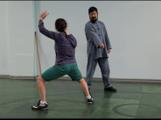When you are stepping, which is a global move called revolution, you are free to move your knee.
Once you finish this move, in which case, you have landed your foot and fixed your foot as an anchor, your knee should also be fixed.
At this point, the knee cannot move any more. It can only rotate, which does not cause any movement or displacement of space. The locking in place (not rigid) of the knee causes the inner kua and the inner arch of the foot to expand along the lines of a curve. This arching action makes the arc similar to that of a bridge. This is also one of the bows of Taijiquan.
As you can see, the locking in place of the knee is crucial in this activity. Any movement of the knee will nullify this effort.
originally published in 2008


